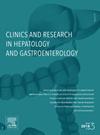Evaluation of a nutritional education guide designed for patients living with cirrhosis: A randomized controlled mixed-methods study
IF 2.4
4区 医学
Q2 GASTROENTEROLOGY & HEPATOLOGY
Clinics and research in hepatology and gastroenterology
Pub Date : 2025-08-13
DOI:10.1016/j.clinre.2025.102672
引用次数: 0
Abstract
Background
Liver diseases are increasingly common in Canada, and patients with cirrhosis are at high risk for malnutrition due to difficulties in meeting energy and protein intake targets. This highlights the need for tailored nutritional interventions. This study evaluates the impact of the Nutrition in Cirrhosis guide on nutritional knowledge, quality of life (QoL), nutritional risk, and dietary intake, as well as patient satisfaction.
Methods
In this randomized controlled mixed-methods study, patients in the intervention group (Guide+) received and used the Guide for 6 months. Data was collected at baseline, 3 months and 6 months. Assessments included evaluation of nutritional knowledge (questionnaire based on the Guide), QoL (Chronic Liver Disease Questionnaire) and nutritional risk (Liver Disease Undernutrition Screening Tool). Satisfaction was evaluated with 3 focus groups including patients from the Guide+ group as well as a patient partner and thematic analysis was conducted.
Results
Thirty-nine patients were randomized into Guide+ (n=23) and Guide- (n=16) groups. The Guide+ group showed significantly greater improvement in nutritional knowledge (p=0.032) compared to Guide-. Knowledge scores increased from 74.3% at baseline to 84.0% after six months (p<0.001), while no significant change was observed in Guide- (p=0.143). Nutritional risk decreased significantly in Guide+ patients (47.8% to 21.7%, p=0.021) but remained unchanged in controls. No significant QoL changes were observed. Focus groups identified three main themes: navigational challenges, outcomes and feelings associated with the Guide.
Conclusion
The Nutrition in Cirrhosis guide effectively improved nutritional knowledge and reduced nutritional risk in cirrhosis patients. Patient feedback highlighted areas for improvement, affirming the guide’s value in supporting nutritional education.
肝硬化患者营养教育指南的评价:一项随机对照混合方法研究。
背景:肝脏疾病在加拿大越来越普遍,肝硬化患者由于难以满足能量和蛋白质摄入目标而处于营养不良的高风险。这突出表明有必要采取有针对性的营养干预措施。本研究评估肝硬化营养指南对营养知识、生活质量(QoL)、营养风险、饮食摄入以及患者满意度的影响。方法:在这项随机对照混合方法研究中,干预组(Guide+)患者接受并使用指南6个月。在基线、3个月和6个月时收集数据。评估包括营养知识评估(基于指南的问卷)、QoL(慢性肝病问卷)和营养风险评估(肝病营养不足筛查工具)。通过3个焦点小组(包括Guide+组患者和患者伴侣)对满意度进行评估,并进行专题分析。结果:39例患者随机分为Guide+组(n=23)和Guide-组(n=16)。与Guide-组相比,Guide+组在营养知识方面有显著提高(p=0.032)。知识得分从基线时的74.3%提高到6个月后的84.0%。结论:肝硬化营养指南有效提高了肝硬化患者的营养知识,降低了营养风险。病人的反馈强调了需要改进的地方,肯定了指南在支持营养教育方面的价值。
本文章由计算机程序翻译,如有差异,请以英文原文为准。
求助全文
约1分钟内获得全文
求助全文
来源期刊

Clinics and research in hepatology and gastroenterology
GASTROENTEROLOGY & HEPATOLOGY-
CiteScore
4.30
自引率
3.70%
发文量
198
审稿时长
42 days
期刊介绍:
Clinics and Research in Hepatology and Gastroenterology publishes high-quality original research papers in the field of hepatology and gastroenterology. The editors put the accent on rapid communication of new research and clinical developments and so called "hot topic" issues. Following a clear Editorial line, besides original articles and case reports, each issue features editorials, commentaries and reviews. The journal encourages research and discussion between all those involved in the specialty on an international level. All articles are peer reviewed by international experts, the articles in press are online and indexed in the international databases (Current Contents, Pubmed, Scopus, Science Direct).
Clinics and Research in Hepatology and Gastroenterology is a subscription journal (with optional open access), which allows you to publish your research without any cost to you (unless you proactively chose the open access option). Your article will be available to all researchers around the globe whose institution has a subscription to the journal.
 求助内容:
求助内容: 应助结果提醒方式:
应助结果提醒方式:


